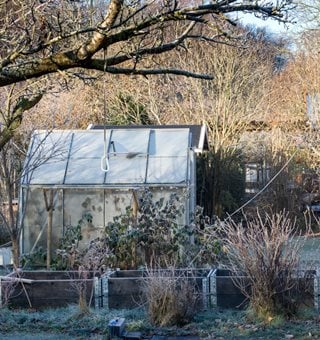Winter Planning
Ideas and insights on what you can do now for a better garden this spring and summer
Photo by: Jon Naustdalslid / Shutterstock.
For those who mourn the slowing down of the gardening season, here’s some good news: Plants may go dormant in winter, but people don’t have to. With fewer attention-grabbing chores, winter is the perfect time to revisit existing designs and reconsider plant palettes. Certain landscaping projects are actually better suited to the off months and there are definite advantages to getting an early start in winter.
ADVANTAGES TO PLANNING IN WINTER
See clearly:
The bones of the garden are exposed in winter, allowing you to easily see what’s out of balance and where you might want to add in structure or visual texture, whether in the form of plants or hardscaping. Rosalia Sanni, a Connecticut-based landscape designer, likes to design in winter because sightlines are exposed when plants and trees have lost their leaves. She can make immediate assessment of which sightlines to keep clear, which views to incorporate or borrow, and which ones to block.
Don't compete:
Sanni also says that hiring a designer in winter means you’re not competing with high-season demands such as installation supervision. “Any client who has me designing in winter has my undivided attention.”
Beat the rush:
Get orders started for long lead-time items, such as outdoor kitchen appliances or specialty items. Don’t let long delivery times in spring push your project off track; order early and keep your project running on time.
Avoid delays:
City or municipal agencies are less likely to be bogged down with plan approvals in winter. Use this time to get a jump on any necessary permits to avoid start-up delays.
FIND FRESH IDEAS
Read up:
Cold winter days are the perfect time to catch up on gardening and design books and magazines. There are so many sources for new ideas, but one of our favorites is The Gardener’s Idea Book. You can request a printed copy or view it online. It’s full of great information, introductions to new plants, and is updated each year. You can also find step-by-step online instructions for featured DIY projects.
Catch up:
Get caught up on all the latest trends in garden design. Get inspired to try something new—grow your own bouquets, design a cottage or mediterranean garden, expand your houseplant collection, add texture to your garden with foliage plants, and more.
Get out:
Steve Gierke, of Hoerr Schaudt Landscape Architects, likes to venture out to local botanical gardens and arboretums to see how characteristics like bark texture and habit have turned summer wallflowers into winter stunners. Or, you don’t even have to venture that far. Take a walk around the block and see what your neighbors’ yards are looking like. Are there varieties you might want to include in your garden to add winter interest?
GET DESIGNING

Snowdrops come up early in the season. Photo by: Abramova Kseniya / Shutterstock.
Design with winter in mind:
Protecting your landscape from winter damage can start in the design process. If you’re in an area that gets snow, make sure you have space to pile it up. Keep landscaping and obstacles away from areas that need to be plowed. Know which direction cold winter winds blow and plan an evergreen hedge or fence to provide a wind break. Become familiar with different sunlight patterns—know if your favorite sun-loving plant might actually be in the shade all winter.
Evaluate winter color:
There's nothing like winter-blooming plants to lift your spirits during the colder months. Shrubs such as witch hazel and honeysuckle offer color and fragrance at a time when you need it most. Early bulbs including snowdrops, crocus and hellebores will even pop up through a shallow cover of snow, giving you hope that spring isn’t too far away. (See more winter-flowering plants.)
Create four-season interest:
Use winter as a time to decide where you might add woody plants that can provide structure and interest all year. In mild climates, plants with contrasting heights, colors, and shapes add interest throughout winter. Add height with vertical shrubs like Sky Box® Japanese holly or Sting™ arborvitae; or rounded shapes with Gem Box® inkberry holly or Tater Tot® arborvitae.
Review photos:
Take a look through garden photos taken throughout the year to remind yourself of gardening successes or failures. Make note of possible improvements, additions, or deletions you’d like to implement in the coming season.
PLANNING AHEAD—WHAT TO DO THROUGHOUT THE YEAR
Take pictures:
Build a photo gallery of monthly photos of your garden. Be sure to include the good, the bad, and the ugly for insights when doing your winter planning next year.
Keep a garden journal:
Include monthly notes in a garden journal of what worked, what didn’t, when plants sprouted or bloomed, and maintenance done.
RELATED:
How to Prepare Your Garden for Winter
Mild Climate Winter Garden To-Do List
Winter Gardening in Cold Climates
Thanks to the following designers:
Rosalia Sanni
rosaliasanni.com

